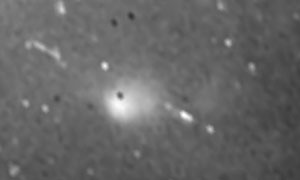Donder en bliksem op Saturnus

“This is the first time we have the visible lightning flashtogether with the radio data,” said Georg Fischer, a radio andplasma wave science team associate based at the Space ResearchInstitute in Graz, Austria. “Now that the radio and visible lightdata line up, we know for sure we are seeing powerful lightningstorms.”
The
The first images of the lightning were captured in August 2009,during a storm that churned from January to October 2009 and lastedlonger than any other observed lightning storm in the solar system.Results are described in an article accepted for publication in thejournal Geophysical Research Letters.
To make a video, scientists needed more pictures with brighterlightning and strong radio signals. Data were collected during ashorter subsequent storm, which occurred from November throughmid-December 2009. The frames in the video were obtained over 16minutes on Nov. 30, 2009. The flashes lasted less than onesecond.
The images show a cloud as long as 3,000 kilometers (1,900 miles)across and regions illuminated by lightning flashes about 300kilometers (190 miles) in diameter. Scientists use the width of theflashes to gauge the depth of the lightning below the cloudtops.
When lightning strikes on Earth and on Saturn, it emits radiowaves at a frequency that can cause static on an AM radio. Thesounds in the video approximate that static sound, based on Saturnelectrostatic discharge signals detected by Cassini’s radio andplasma wave science instrument.
Since Cassini’s arrival at Saturn in 2004, it has been difficultto see the lightning because the planet is very bright andreflective. Sunlight shining off Saturn’s enormous rings made eventhe night side of Saturn brighter than a full-moon night on Earth.Equinox, the period around August 2009 when the sun shone directlyover the planet’s equator, finally brought the needed darkness.During equinox, the sun lit the rings edge-on only and left thebulk of the rings in shadow.
Seeing lightning was another highlight of the equinox period,which already enabled scientists to see clumps in the rings as highas the Rocky Mountains. “The visible-light images tell us a lotabout the lightning,” said Ulyana Dyudina, a Cassini imaging teamassociate based at Caltech, who was the first to see the flashes.”Now we can begin to measure how powerful these storms are, wherethey form in the cloud layer and how the optical intensity relatesto the total energy of the thunderstorms.”
Meest Gelezen
Vrouwen houden universiteit draaiende, maar krijgen daarvoor geen waardering
Wederom intimidatie van journalisten door universiteit, nu in Delft
Hbo-docent wil wel rolmodel zijn, maar niet eigen moreel kompas opdringen
‘Burgerschapsonderwijs moet ook verplicht worden in hbo en wo’
Raad van State: laat taaltoets nog niet gelden voor hbo-opleidingen



